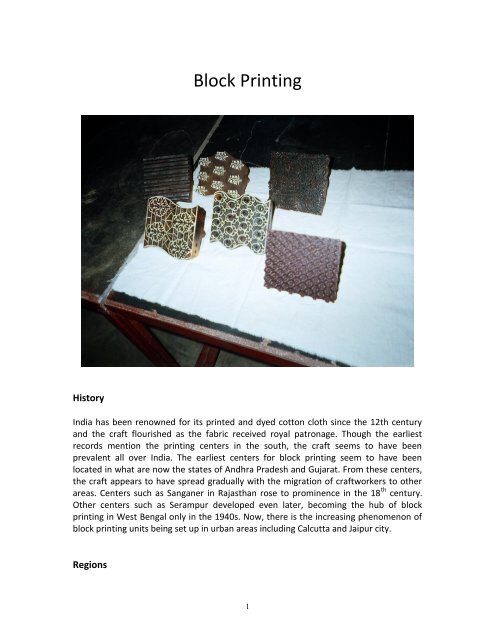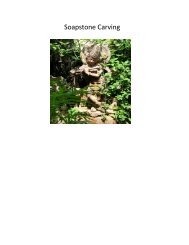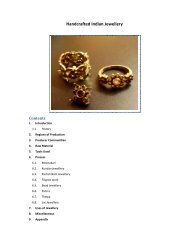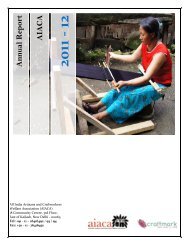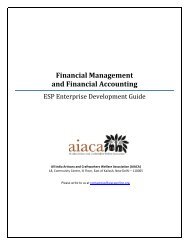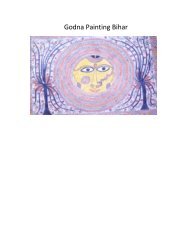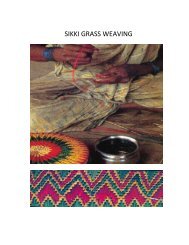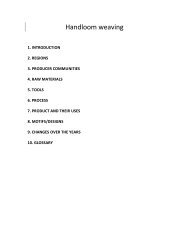Block Printing - All India Artisans and Craftworkers Welfare Association
Block Printing - All India Artisans and Craftworkers Welfare Association
Block Printing - All India Artisans and Craftworkers Welfare Association
You also want an ePaper? Increase the reach of your titles
YUMPU automatically turns print PDFs into web optimized ePapers that Google loves.
History<br />
<strong>Block</strong> <strong>Printing</strong><br />
<strong>India</strong> has been renowned for its printed <strong>and</strong> dyed cotton cloth since the 12th century<br />
<strong>and</strong> the craft flourished as the fabric received royal patronage. Though the earliest<br />
records mention the printing centers in the south, the craft seems to have been<br />
prevalent all over <strong>India</strong>. The earliest centers for block printing seem to have been<br />
located in what are now the states of Andhra Pradesh <strong>and</strong> Gujarat. From these centers,<br />
the craft appears to have spread gradually with the migration of craftworkers to other<br />
areas. Centers such as Sanganer in Rajasthan rose to prominence in the 18 th century.<br />
Other centers such as Serampur developed even later, becoming the hub of block<br />
printing in West Bengal only in the 1940s. Now, there is the increasing phenomenon of<br />
block printing units being set up in urban areas including Calcutta <strong>and</strong> Jaipur city.<br />
Regions<br />
1
<strong>Block</strong> printing is practiced in many different geographical regions of <strong>India</strong> with each area<br />
having its own particular local aesthetic. The main centers where block printing is<br />
practiced are:<br />
Andhra Pradesh: Hyderabad, Machalipattnam (Kalamkari)*<br />
Gujarat: Ahmedabad (Pethapur), Kutch, Porb<strong>and</strong>ar, Rajkot<br />
Rajasthan: Bagru, Chittroli, Sanganer, Jaipur, Jodhpur<br />
Madhya Pradesh: Bagh, Behrongarh, Indore, M<strong>and</strong>sar, Burhanpur<br />
Uttar Pradesh: Benares (<strong>Block</strong>-makers), Farrukabad, Pilakhuan (<strong>Block</strong>makers)<br />
West Bengal: Calcutta, Serampur<br />
Each of these regions traditionally had distinct design elements with unique color<br />
schemes <strong>and</strong> motifs. Although the commercialization of the craft has seen a<br />
convergence in design elements between the various regions, block printed fabric by<br />
expert craftworkers from each of these regions are still identifiable by its region of<br />
origin.<br />
<strong>Block</strong> printing at Bagru<br />
Bagru a small town situated 32 kms south-west of Jaipur is famous for its traditional<br />
h<strong>and</strong> block printed fabrics. The block printing craft of Bagru is unique <strong>and</strong> has its own<br />
distinct character. Bagru was historically recognized as producing more upscale products<br />
for royal clientele <strong>and</strong> for use in temples. Bagru textiles are said to be more authentic<br />
<strong>and</strong> natural, less influenced by the popular market <strong>and</strong> industrial mechanization than<br />
Bagru’s nearby neighbors.<br />
Producer Communities<br />
The “Chhipa” community who is engaged in this traditional craft has settled here from<br />
various parts of Northern <strong>and</strong> Western <strong>India</strong>, has gracefully carried forward this<br />
traditional art form, over successive generations. The printers interact with each other<br />
quite often under the community umbrella called ' Chhipa Samaj '.<br />
Raw Materials<br />
<strong>Block</strong> printing has become popular because the simple process can create intricate<br />
designs in rich <strong>and</strong> vibrant colors. Originally natural dyes were used but today they have<br />
been replaced by chemical <strong>and</strong> artificial colors.<br />
2
[Photograph 1: Chemical <strong>and</strong> artificial colours]<br />
Tools<br />
The main tools of the printer are wooden blocks in different shapes - square, rectangle,<br />
oval, round <strong>and</strong> semi-circular or crescent - <strong>and</strong> sizes called bunta. <strong>Block</strong>s are h<strong>and</strong>carved<br />
of seasoned teak wood by trained craftsmen. On the bottom face the motif are<br />
engraved with steel chisels of different widths <strong>and</strong> cutting surface by the carver. Each<br />
block has a wooden h<strong>and</strong>le <strong>and</strong> two to three cylindrical holes drilled into the block for<br />
free air passage <strong>and</strong> also to allow release of excess printing paste. The new blocks are<br />
soaked in oil for 10-15 days to soften the grains in the timber. These blocks sometimes<br />
have metal over the wood.<br />
[Photograph 2 & 3: Wooden blocks 1, wooden blocks 2]<br />
Metal sheets are beaten by h<strong>and</strong> <strong>and</strong> made wafer thin <strong>and</strong> malleable. The thin sheets<br />
are then cut into strips of even length. The design of the block is drawn on the wooden<br />
block <strong>and</strong> the thin metal strips are pressed onto the design <strong>and</strong> gently hammered in.<br />
The designs are filled in from the center to the outside to allow maneuverings of the<br />
3
h<strong>and</strong>. After the design is completed the design is checked to see if all the brass strips are<br />
of the same height from the wooden base. This is to ensure good high level of printing.<br />
Brass blocks are used in case of very fine designs <strong>and</strong> for a high level of clarity in print.<br />
They also last much longer <strong>and</strong> are more expensive <strong>and</strong> time consuming to make.<br />
[Photograph 4 & 5: Wooden block making process 1, 2]<br />
<strong>Printing</strong> Process<br />
<strong>Block</strong> printing is undertaken on both cotton <strong>and</strong> silk fabrics of varying counts. The fabric<br />
requires a pre-printing treatment where the fabric to be printed is washed free of starch<br />
<strong>and</strong> soft bleached if the natural grey of the fabric is not desired. If dyeing is required as<br />
in the case of saris, where borders or the body is tied <strong>and</strong> dyed, it is done before<br />
printing. The fabric is stretched over the printing table <strong>and</strong> fastened with small pins (in<br />
the case of saris the pallu is printed first then the border).<br />
[Photograph 6: Fabric to be printed is washed]<br />
Historically, the fabric was stretched across a low table, usually about 2 feet wide <strong>and</strong> 5<br />
feet long, <strong>and</strong> the craftworker sat on the floor while imprinting the fabric. However,<br />
since 1950, this has gradually changed with the tables now being waist high <strong>and</strong><br />
measuring approximately 3 feet wide <strong>and</strong> 9 feet long. [L 9 X W 3 X H 3 feet] Each table<br />
4
now may have multiple block printers working simultaneously on imprinting the fabric<br />
depending upon the intricacies of the design.<br />
The block printer pushes along small wooden trolleys with racks that have castor wheels<br />
fastened to their legs to facilitate free movement as he works. On the upper most shelf<br />
trays of dye are placed. On the lower shelves printing blocks are kept ready.<br />
These blocks are then dipped in dye <strong>and</strong> imprinted on to the fabric by a skilled blockprinter.<br />
The printing starts form left to right. The color is evened out in the tray with a<br />
wedge of wood <strong>and</strong> the block dipped into the outline color (usually black or a dark<br />
color). When the block is applied to the fabric, it is slammed hard with the fist on the<br />
back of the h<strong>and</strong>le so that a good impression may register. A point on the block serves<br />
as a guide for the repeat impression, so that the whole effect is continuous <strong>and</strong> not<br />
disjoined. The outline printer usually is more experienced because he is the one who<br />
leads the process.<br />
[Photograph 7: Cloth printing by the master block printer]<br />
If it is a multiple color design the second printer dips his block in color again using the<br />
point or guide for a perfect registration to fill in the color. The third color if existent<br />
follows likewise. Skill is necessary for good printing since the colors need to dovetail into<br />
the design to make it a composite whole. A single color design can be executed faster, a<br />
double color takes more time <strong>and</strong> multiple color design would mean additional labor<br />
<strong>and</strong> more color consumption.<br />
Different dyes are used for silk <strong>and</strong> cotton. Rapid fast dyes, indigo sol <strong>and</strong> pigment dyes<br />
are cotton dyes. <strong>Printing</strong> with rapid dyes is a little more complicated as the dyes once<br />
mixed for printing have to be used the same day. St<strong>and</strong>ard colors are black, red, orange,<br />
brown <strong>and</strong> mustard. Color variation is little difficult <strong>and</strong> while printing it is not possible<br />
to gauge the quality or depth of color.<br />
5
[Photograph 8: Colours]<br />
It is only after the fabric is processed with an acid wash that the final color is<br />
established. Beautiful greens <strong>and</strong> pinks are possible with indigo sol colors but pigment<br />
colors are more popular today because the process is simple, the mixed colors can be<br />
stored for a period of time, subtle nuances of colors are possible, <strong>and</strong> new shades<br />
evolve with the mixing of two or three colors. Also the colors are visible as one prints<br />
<strong>and</strong> do not change after processing. Colors can be tested before printing by merely<br />
applying it onto the fabric. The pigment color is made up of tiny particles, which do not<br />
dissolve entirely <strong>and</strong> hence are deposited on the cloth surface while rapid dyes <strong>and</strong><br />
indigo sols penetrate the cloth.<br />
[Photograph 9: Fabric is processed with acid wash]<br />
Pigment colors are mixed with kerosene <strong>and</strong> a binder. The consistency should be just<br />
right, for if it is too thick it gives a raised effect on the material, which spoils the design.<br />
Small plastic buckets with lids are ideal for storing the mixed colors over a few days.<br />
Fabrics are dried out in the sun after the pigment printing as part of the fixing process.<br />
They are rolled in wads of newspapers to prevent the dye form adhering to other layers<br />
<strong>and</strong> steamed in boilers constructed for the purpose. Silks are also steamed this way<br />
after printing. After steaming, the material is washed thoroughly in large quantities of<br />
6
water <strong>and</strong> dried in the sun, after which it is finished by ironing out single layers, which<br />
fix the color permanently.<br />
[Photograph 10: Fabrics are dried out in the sun]<br />
The craft of <strong>Block</strong> printing is therefore characterized by the following processes that are<br />
integral to the craft:<br />
The blocks for imprinting are h<strong>and</strong>-carved by skilled artisans in wood<br />
These h<strong>and</strong>-carved block are used to imprint the design onto the fabric<br />
The imprinting is done by h<strong>and</strong> by a skilled block printer<br />
Motifs<br />
The style <strong>and</strong> motifs of block prints are inspired from the local sources <strong>and</strong> can be<br />
largely grouped as floral, figurative <strong>and</strong> geometric categories. The designs have large<br />
bootas, small bootis, trellis or jal, (kind of designs) small border <strong>and</strong> large borders <strong>and</strong><br />
sometimes geometrical designs also. Generally each design has 2-4 colors. Each color<br />
has a separate block. Sometimes as many as 5-8 blocks are used depending on the<br />
design. However the cost of block making <strong>and</strong> production goes up accordingly.<br />
Market<br />
Even though the traditional block printing craft has flourished over the past three<br />
decades, with increasing dem<strong>and</strong> from both export <strong>and</strong> domestic markets, blockprinting<br />
faces an increasing threat from the mushrooming of screen-printing units that<br />
are selling their products – often, designs copied from block prints – as genuine block<br />
printed products.<br />
7
Appendix 1: A Brief Description of Dyes<br />
Pigment dyes<br />
Pigment colors are mixed with kerosene <strong>and</strong> a binder. The consistency should be just<br />
right, for if it is too thick it gives a raised effect on the material, which spoils the design.<br />
Small plastic buckets with lids are ideal for storing the mixed colors for a few days. The<br />
motif is printed directly on white or light-colored ground with a variety of pigment<br />
colors.<br />
Pigment colors are widely popular today because the process is simple, the mixed colors<br />
can be stored for a period of time, subtle nuances of colors are possible, <strong>and</strong> new<br />
shades evolve with the mixing of two or three colors. Also the colors are visible as one<br />
prints <strong>and</strong> do not change after processing. Colors can be tested before printing by<br />
merely applying it onto the fabric. The pigment color is made up of tiny particles, which<br />
do not dissolve entirely <strong>and</strong> hence are deposited on the cloth surface while rapid dyes<br />
<strong>and</strong> indigo sols penetrate the cloth.<br />
Rapid fast Colors<br />
In this process, the ground color <strong>and</strong> the color in the design are printed on white <strong>and</strong>/or<br />
light-colored grounds in one step. The dyes once mixed for printing have to be used the<br />
same day. St<strong>and</strong>ard colors are black, red, orange, brown <strong>and</strong> mustard. Color variation is<br />
somewhat difficult <strong>and</strong> while printing it is not possible to gauge the quality or depth of<br />
color.<br />
Discharge Dyes<br />
These dyes are used if you need to print onto a dark background. Medium to dark<br />
grounds are dyed on fabric with specially prepared dyestuff. The printing colors then<br />
used on the fabric contain a chemical that interacts with the dye. This interaction<br />
simultaneously bleaches the color from the dyed ground <strong>and</strong> prints the desired color on<br />
its place. Areas can also be discharged <strong>and</strong> left white. The primary advantage of this<br />
process is that vivid <strong>and</strong> bright colors along with white can be printed on top of medium<br />
<strong>and</strong> dark grounds.<br />
Napthol / Reactive dyes<br />
As the name suggests, these are two sets of chemicals, which upon reaction produce a<br />
third chemical essentially colorful in nature. Fabric is dyed in one <strong>and</strong> later printed with<br />
the other. The chemical reaction produces a third color. However, the biggest drawback<br />
of this process is that there are just a few chemicals available, which produce colors<br />
upon reaction.<br />
8
Vegetable / Natural dyes<br />
Historically of great importance, these dyes have acquired even greater importance now<br />
because of their eco-friendly nature.<br />
Bagru Black<br />
This is derived by mixing acidic solution of iron - often rusted nails/horse shoes etc. with<br />
jaggery (country sugar) allowed to rot for about 10-15 days. Many other natural<br />
substances used for producing dyes are pomegranate skins, bark of mango tree, vinegar,<br />
slaked lime etc.<br />
Bagru Red<br />
This dye is achieved by combining a source material such as alizarin with alum, the<br />
results ranging from pink to deep red.<br />
Indigo Blue<br />
The internationally famous Bagru Blue is obtained from the indigo bush found<br />
throughout <strong>India</strong><br />
Source: www.sashaworld.com<br />
9
Appendix 2 – Bibliography | Research Work Consulted<br />
Hatanaka, Kokyo; <strong>and</strong> Zahid Sardar. Textile Arts of <strong>India</strong>. San Fransico: Chronicle Books,<br />
1996.<br />
Mohanty, Bijoy Ch<strong>and</strong>ra; <strong>and</strong> Jagadish P. Mohanty. <strong>Block</strong> <strong>Printing</strong> <strong>and</strong> Dyeing of Bagru.<br />
Ahmedabad: Calico Museum of Textiles, 1983,<br />
Sasha < http://www.sashaworld.com/block/block.htm> (29 September 2003)<br />
<strong>India</strong> Crafts < http://www.india-crafts.com/textile_products/blockimpressions.html> (25<br />
September 2003)<br />
For a more detailed description <strong>and</strong> information on the history <strong>and</strong> techniques of block<br />
printing we recommend that you consult the above sources directly.<br />
Information in this note also based on primary interviews with block printers <strong>and</strong> field<br />
visits to block printing clusters.<br />
10


